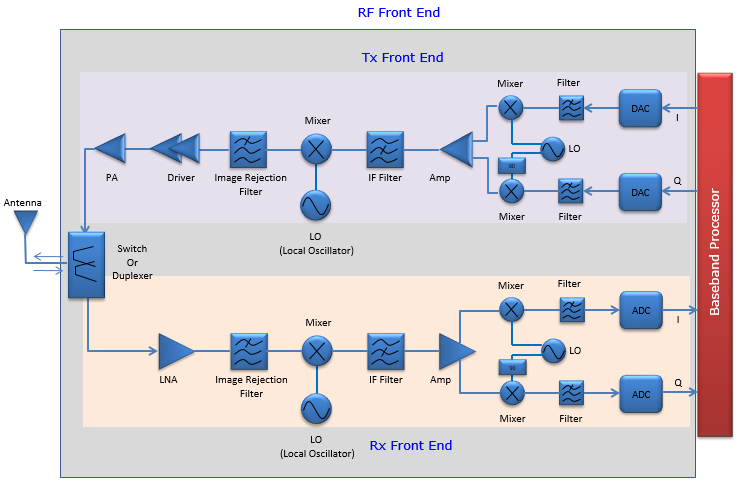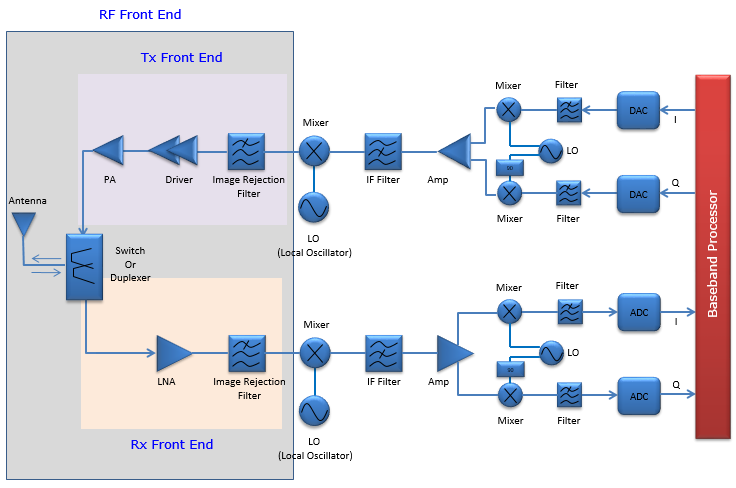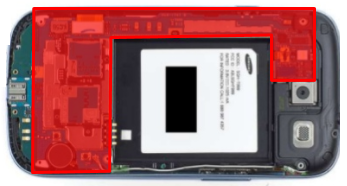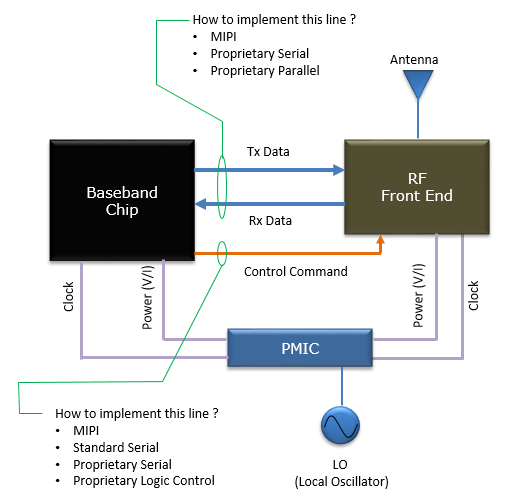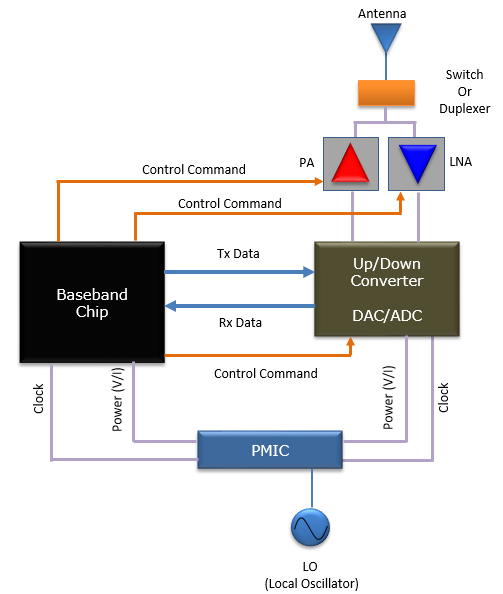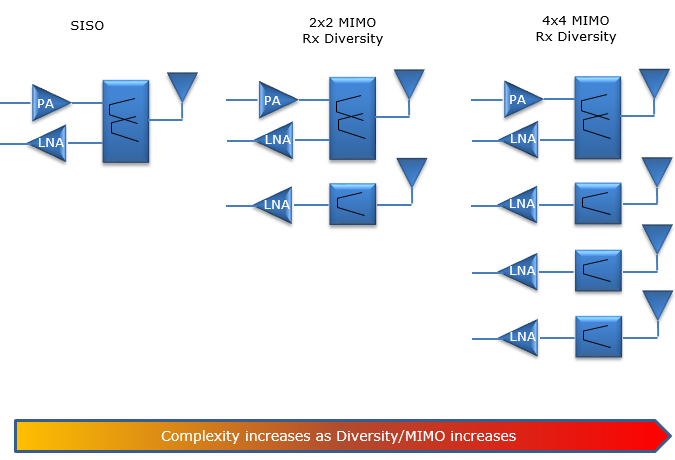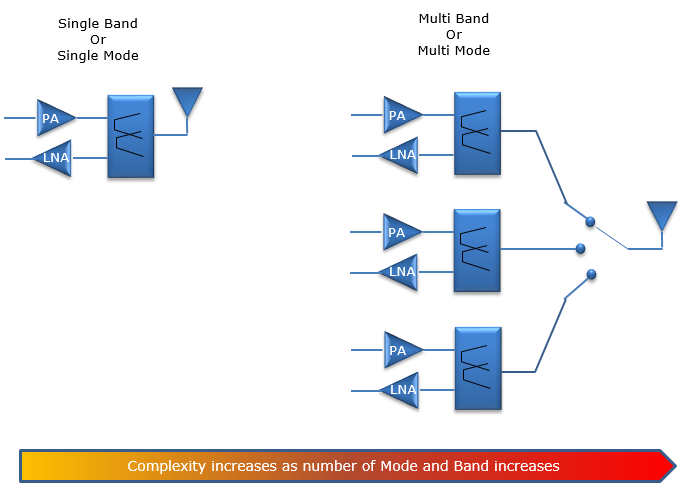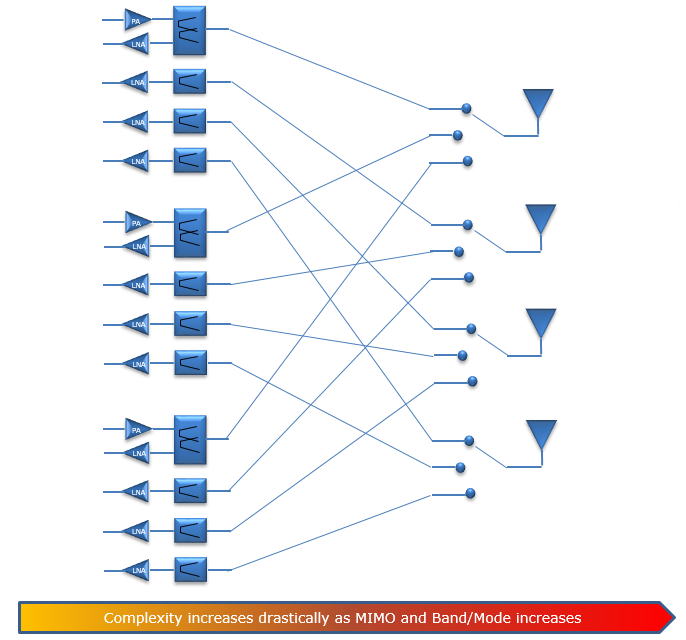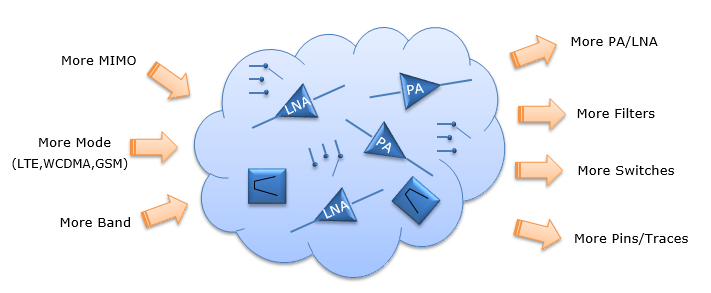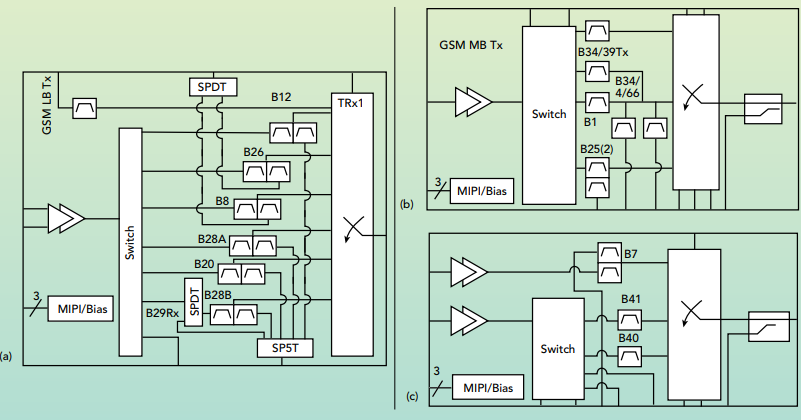|
RF |
||
|
RF Front End
What is RF Front End (RFFE) ? As for many other technical terms, the term "RF Front End" has several different variations of definitions from narrow to wide meaning. I would introduce two different versions of definition that I think defines well. I strongly recommend you to read the both references that I linked here and it will give you pretty good big picture on RF Front End.
According to Reference [1], RF Front End is defined as follows : The RF front end is generally defined as everything between the antenna and the digital baseband system. For a receiver, this "between" area includes all the filters, low-noise amplifiers (LNAs), and down-conversion mixer(s) needed to process the modulated signals received at the antenna into signals suitable for input into the baseband analog-to-digital converter (ADC). For this reason, the RF front end is often called the analog-to-digital or RF-to-baseband portion of a receiver.
According to this definition, roughly the area in the gray area would be defined as RF Front End.
[Figure 1]
According to Reference [4], it is stated as follows. The RFFE in a UE is made up of a number of key components:
The Baseband and RF (mixers, down converter, etc.) section, a key component in the overall UE, is not part of the RFFE
According to this definition, the RF Front End can be highlighted in gray as follows :
[Figure 2]
Which one is the correct definition ? Both can be correct depending on the context. I personally use the first definition when I am referring to RFFE(RF Front End) in this page. However, most of the detailed description would be around the section in the second definition.
RF Front End (RFEE) Getting Into a Chip and Why ?
In recent radio technology, at least speaking of cellular phone, the area for PCB(Printed Cirbuit Board) is not so wide in a mobile phone as highlighted in red shown below. Even in the limited area, the space that can be allocated for RF front end is only a small portion of the PCB. It is very difficult (almost impossible) to put all of the discrete RF component in the area.
[Figure 3]
You may say 'recently we see tendancies for the size of the mobile phone to get larger and larger. and we would have larger spaces for RF components'. However, it is only one aspect. As we see larger device in one aspect, we see larger battery size due to higher energy comsumption requirement and there are more requirement for a phone to support more bands (different frequencies) and multi mode(GSM, WCDMA, LTE all in single phone). Therefore, the space for RF front end is still tight. Even with assumption that you have enough space to put all those components in discrete manner, you would need to invest a lot of time and effort to tune and match each and every discrete components. (Of course, this way of implementation would create a best job market for RF engineers :) One of the best solution would be to put all of those components into one or a few small packages and use them like an IC (Integrated Circuit). As far as I know as of now (Mar 2018), almost every cellular device use this kind of integrated RF IC (module) rather than using discrete devices. If you are more interested in what kind of RF Front End module are used in real commercial phone, see Ref[8] which would show you very nicely summarized examples from various commercialized phone.
Several different implementations of RF Front End
Once all (or most) of RF components get into a chip (or package), integrating the RF into a device (e.g, mobile phone) is like a digital embedded system rather than RF/Analog system. Admitting that this might be oversimilification, modern mobile phone structure in terms of radio stack hardware can be illustrated as follow. As you see here, even though most of the discrete RF components are analog devices the front end chipset (or the package) become like a digital chipset. It provides various control and data line that communicate with micro controller chipset(Baseband chip in this case).
[Figure 4]
The illustration shown above is the case of maximum integration of RF Front End in which all of the RF components (e.g, PA, LNA, Filters) and Up/Down converters are integrated in a single chip. This might be the best solution for the hardware engineers who has to design and implement the board. However, there are some cases where we implement the RF Front End as two chip as illustrated below. In this type, pure RF components (Amplifier, Switch / Diplexer / Duplexer) are integrated in a separate chipset from the Up/Down Converter chipset. This type of architecture would add a little bit more complexity comparing to the previous architecture, but there is motivation for this type of architecture. It is hard for one company to be the best for every field. There can be a company that is more specialized in Up/Down Converter and DAC/ADC part and another company that is better fit for pure RF modules. By adopting this architecture, we can better optimize the hardware performance. Or in somecases this architecture may save hardware cost as well if you are good enough at bargaining with two different component vendors :).
[Figure 5]
By extending the logic mentioned above to a little bit further, we may think of using Tx RF module (PA module) and Rx RF module (LAN) in seprate chipset as illulstrated below.
[Figure 6]
Complexity Explosion ?
You may easily guess the functionality of the modern mobile phone has become extremely complicated in terms of radio stack. The driving force for these complexity can be listed as below (as of Mar 2018) :
How these complexity of the radio stack impact on the complexity of RF Front End structure ? Speaking of the complexity, we may think of complexity in Up/Down converter and ADC, and pure RF part (PA, LNA, Filter Switch). Even though the radio stack complexity would lead to complexity of both part, the impact will be bigger on pure RF part. So let's think of the impact on the complexity of pure RF part here.
First, let's think of the case where we add more MIMO/Diversity functionality and guess how the RF part gets complicated. Intuitively you can think of a progression as illustrated below.
Now think of the case where we add more radio technology or bands and see how this influence on the RF part complexity. This progression can be illustrated as follows.
Now a question would pop up in your mind ? What if we add both more MIMO and more bands simultaneosuly ? You can guess easily that I am running out paper to plot multiple cases here for comparision -:), so I would show only one case as below.
Summing up all of what is mentioned above, we can reach a simple / illustrative conclusion as shown below in terms of the complexity of RF Front End and the factors that lead to the complexity.
Then another question would arise in your mind ? Would this complexity would hit any maximum point and we cannot add any more function ? If you just think of putting the components in linear fashion as illustrated above, you may reach the point where you cannot add any more parts in small front end chipset. However we have always seen such a great minds that overcome almost every hurdles in engineering. It applies to this area as well. RF frontend manufactureres have made a lot of efforts to optimize and simplify the front end design even with more functionality. One example is show below. This is from Reference [7]. This shows an example of integrating the PAs, switches and filters into three front-end modules that cover the low (a) mid (b) and high (c) bands. Considering the number of bands it supports, you would see that is is simpler than you might have imagined.
Any Idea to prevent the complexity explosion ?
As mentioned above, there has been a lot of effort to reduce the complexity as we put more functionalities into a Front End module. What kind of idea is out there to achieve this goal ? Several ideas are known as below. Some of them are already being used and some of them are at the stage of investigation.
Reference :
[1] What's in an RF Front End? (EE Times) [2] RF front-end solutions for mobile applications (Infineon) [3] SKY68001-31: LTE Universal Multi-Band Front-End Module for IoT [4] Wireless Handset RF Front-End Optimization (4G Americas) [5] SKY66420-11: 860 to 930 MHz RF Front-End Module [6] Smartphone Hardware Architecture (Slideshare) [7] Evolution of the Smartphone (Microwave Journal) [8] In 5G smartphone designs, RF Front-End graduates from traditional supporting role to co-star with modem
|
||
